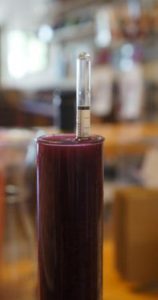Time to Press the “3 Texan” Cabernet Sauvignon
The hardest decision for me as a winemaker is trying to decide when to press the red wine. On one hand, an extended time with the skins could mean more maceration, or in other words, better tannin extraction, richer color and improved flavor, but the risk of spoilage and too much of a good thing weigh heavily on my mind. I generally press the red wine when all, or nearly all (as seen in the hydrometer picture) of the sugar has been consumed.
Wikipedia.org has a good entry explaining what I am talking about…
“The timing of pressing and the methods used will have an impact on other decisions in the winemaking process. In white wine making, pressing usually happens immediately after harvest and crushing. Here, the biggest decision will be how much pressure to apply and how much pressed juice the winemakers wants in addition to the free-run juice. Some grape varieties, such as Sémillon and Aurore have very “liquidy” pulps that releases juice easily without needing much pressure that could risk tearing the skins. Other varieties, such as Catawba, have much tougher pulps that will require more pressing.[7]
In red wine production the timing of when to press is one of the most important decisions in the wine making process since that will be the moment that maceration and phenolic extraction ceases. Some winemakers use the decreasing sugar level (such as brix measurement) scale and press once the wine has reached complete dryness. Often winemakers will use taste to determine if the wine has extracted enough tannins to produce a balanced wine and may press before complete dryness (such as at 3-8 brix). Though removing the skins by pressing often removes some solids that the wine yeast need to complete fermentation and the benefits of pressing early is often balanced by the risk of potential stuck fermentation.[4]
The quality of the vintage year and the overall ripeness of the harvested grapes may also play a role since in cool years when the grapes are often harvested under-ripe, the tannins in the grape are often very “green” and harsh. In these years winemakers might press early (such as at 15 brix), a process that the Australians call “short vatting”. In warmer years, the tannins may be full ripe or “sweet” and the winemaker may decide to do a period of extended maceration and not press the grapes for as long as a month after fermentation has completed.[4]”
This was found at at http://en.wikipedia.org/wiki/Pressing_(wine)#When_to_press_and_other_winemaking_decisions:


